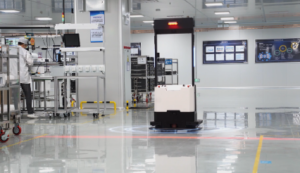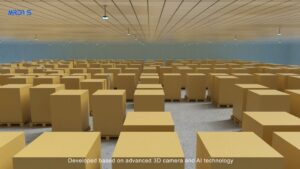Imagine a robot navigating a complex environment, effortlessly avoiding obstacles and mapping its surroundings in real time. Behind this impressive capability lies advanced 3D sensing technology — primarily
LiDAR and
RGB-D cameras. But what exactly sets these two apart? Choosing the right camera can make all the difference in accuracy, range, and application performance. In this article, we’ll break down the key differences between LiDAR cameras and RGB-D cameras to help you pick the perfect fit for your robotics or industrial vision projects.
What Are LiDAR Cameras
LiDAR (Light Detection and Ranging) cameras are advanced sensing devices that use laser pulses to measure distances with high precision. By emitting laser beams and calculating the time it takes for them to bounce back from objects, LiDAR cameras generate accurate 3D representations of the environment—commonly known as point clouds.
Unlike traditional vision systems, LiDAR doesn’t rely on ambient light or visible images. This makes it highly effective in low-light, outdoor, or complex environments where traditional cameras may struggle. LiDAR cameras are widely used in autonomous vehicles, drones, mobile robots, and industrial automation where real-time, high-resolution spatial data is essential.
At
MRDVS, we specialize in developing LiDAR-integrated vision systems that deliver the accuracy and reliability needed for next-generation robotic applications.
What Are RGB-D Cameras
RGB-D cameras are depth-sensing devices that combine traditional color imaging (RGB) with depth information (D) to capture a more complete view of the environment. Unlike standard cameras that only record flat, 2D visuals, RGB-D cameras can perceive the distance of objects from the sensor—adding a third dimension to every frame.
These cameras typically use technologies like
structured light or
time-of-flight (ToF) to measure depth. The structured light method projects a known pattern onto a scene and calculates depth based on how the pattern distorts, while ToF sensors measure the time it takes for infrared light to reflect back from surfaces.
RGB-D cameras are ideal for indoor applications such as AR/VR, gesture recognition, object tracking, and mobile robot navigation. They provide real-time depth maps alongside full-color video, making them a cost-effective solution for environments where extreme precision or long-range sensing is not required.
At MRDVS, we develop RGB-D camera systems that deliver synchronized color and depth data—empowering intelligent vision for mobile robots and autonomous systems.
Key Differences Between LiDAR and RGB-D Cameras
When selecting a 3D sensing solution, understanding the distinctions between LiDAR and RGB-D cameras is critical. Here’s a breakdown of the core differences between the two technologies:
-
Sensing Technology
LiDAR cameras use laser pulses to measure distances with high precision, emitting light and detecting how long it takes for the pulse to return after hitting an object. This creates highly accurate 3D point clouds that can be used to map environments. On the other hand, RGB-D cameras combine standard color (RGB) imaging with depth data. They use technologies like structured light or time-of-flight (ToF) to estimate the distance to objects and generate depth maps alongside visual data.
-
Depth Accuracy and Range
LiDAR cameras excel in offering exceptional depth accuracy and long-range sensing capabilities. They can capture data from hundreds of meters away, making them suitable for large-scale outdoor environments such as autonomous vehicle navigation or industrial mapping. In contrast, RGB-D cameras typically work within a shorter range—usually around 10 meters or less—and are most effective in controlled, indoor environments. Their depth accuracy may be less precise than LiDAR, especially at greater distances.
-
Environmental Performance
One of LiDAR’s key advantages is its ability to operate in various lighting conditions, from bright sunlight to complete darkness. This makes it highly reliable for outdoor use, where varying light conditions are common. RGB-D cameras, however, are more susceptible to environmental factors such as ambient lighting or reflective surfaces, which can interfere with depth sensing. They work best in consistent, low-light environments, making them ideal for indoor applications like robotics and AR.
-
Cost and Complexity
LiDAR cameras are generally more expensive due to their advanced technology and the complexity of their components. They require higher processing power and more sophisticated integration into systems, making them a significant investment for commercial or industrial applications. In contrast, RGB-D cameras are more affordable and accessible, often used in consumer-level products. They provide a simpler, cost-effective solution for many applications but come with trade-offs in terms of depth range and accuracy.
-
Data Output and Use Case Fit
LiDAR cameras produce 3D point clouds, which offer detailed, precise data about an environment’s shape and structure but lack color information. This makes them ideal for tasks like 3D mapping, autonomous navigation, and
obstacle detection. RGB-D cameras, however, combine both color and depth data, which is valuable in applications requiring visual context, such as augmented reality (AR), robotics, or object tracking. The addition of color information makes them suitable for environments where both appearance and depth need to be analyzed simultaneously.
Here is a table to help you better understand the differences between LiDAR and RGB-D cameras.
|
Feature
|
LiDAR Camera
|
RGB-D Camera
|
|
Sensing Technology
|
Uses laser pulses to measure distance and create 3D point clouds
|
Combines RGB imaging with depth via structured light or ToF
|
|
Depth Accuracy & Range
|
High precision with long-range capabilities (up to 100+ meters)
|
Moderate precision with short-range depth sensing (usually <10 meters)
|
|
Environmental Performance
|
Works reliably in all lighting conditions, including darkness and sunlight
|
Performance may degrade in bright light or reflective environments
|
|
Cost & Complexity
|
Higher cost and system complexity, suitable for industrial-grade applications
|
Lower cost, compact, and easier to integrate into consumer or indoor systems
|
|
Data Output
|
Generates 3D point clouds without color information
|
Provides combined color and depth images (RGB + Depth Map)
|
|
Best Use Cases
|
Ideal for autonomous vehicles, drones, outdoor mapping, and industrial robots
|
Great for AR/VR, indoor robotics, gaming, and gesture recognition
|

How to Choose the Right Camera for Your Needs
Selecting the right camera for your project is critical to ensuring performance, accuracy, and cost-efficiency. Whether you’re working on autonomous navigation, industrial robotics, or AR/VR systems, the choice between LiDAR and RGB-D cameras depends on your specific use case. Here’s a guide to help you make the right decision—with MRDVS offering solutions for both technologies.
-
Consider Your Environment
Outdoor Applications: For projects involving outdoor mapping, navigation, or surveillance in dynamic lighting conditions, LiDAR cameras are the superior option. Their long-range capabilities and lighting independence make them ideal for autonomous vehicles and field robotics.
Indoor Applications: RGB-D cameras from MRDVS are optimized for indoor environments, providing both depth and color data for applications such as service robots, AR/VR, and smart automation.
-
Determine the Accuracy You Need
High Accuracy Requirements: If you need precise spatial data for applications like 3D reconstruction or autonomous obstacle detection, MRDVS’s LiDAR-equipped vision systems deliver the accuracy and reliability required for high-stakes tasks.
Moderate Accuracy Tasks: For scenarios like object recognition or indoor tracking, MRDVS RGB-D cameras offer a practical and efficient solution with enough precision to support interactive and real-time applications.
-
Evaluate the Sensing Range
Long-Range Sensing: When your application demands coverage of large areas or navigation over long distances, LiDAR systems are ideal, offering detection ranges beyond 100 meters.
Short to Mid-Range Needs: For depth sensing within 1–10 meters, RGB-D cameras from MRDVS provide excellent performance, ideal for confined indoor spaces or desktop robotic systems.
-
Factor in Your Budget
Premium Projects: If your budget allows for cutting-edge performance and durability, LiDAR is a strong investment for long-term, industrial-grade projects.
Cost-Conscious Applications: For developers, startups, or researchers looking to balance cost and functionality, MRDVS RGB-D cameras offer high-quality depth sensing at a more accessible price point.
-
Match the Camera to Your Application
Autonomous Robotics and Drones: For fast, accurate, real-time 3D mapping, MRDVS LiDAR camera systems offer the precision needed for robust autonomy.
AR/VR and Indoor Navigation: For visually rich, interactive systems, MRDVS RGB-D cameras provide synchronized depth and color data that enhance real-world integration.
Conclusion
Choosing between a LiDAR camera and an RGB-D camera ultimately depends on your project’s specific needs—whether it’s long-range, high-precision mapping or indoor, color-rich depth sensing. Both technologies have their unique strengths, and understanding these differences will help you make the best choice.
At MRDVS, we offer advanced solutions featuring both LiDAR and RGB-D cameras, designed to meet a wide range of industrial, robotic, and autonomous system requirements. Explore our product lineup today to find the perfect vision system that will elevate your project’s performance and reliability.


